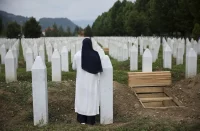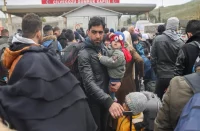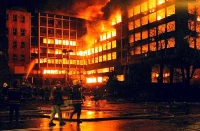The summer of 1990 was extremely hot in Kosovo for the reason that on July 2nd, Kosovo Albanians issued a declaration of independence within Yugoslavia that was, actually, a political revolt to the fact that on June 26th, using temporary measures, Belgrade took over (according to Serbian authorities, on the quite legal and legitimate way) provincial political competences of Kosovo Province by imposing new law on the Activities of the Institutions of the Republic under Exceptional Circumstances. The declaration of independence was proclaimed by 114 out of 123 members of the Assembly (the Parliament) of Kosovo Province on the meeting in the street outside of the closed building of the Assembly. In fact, what they declared was that Kosovo to be an “equal and independent entity within the framework of the Yugoslav federation”, or in other words a Yugoslav “Republic of Kosovo” (Kosova in Albanian).
As a reaction to such declaration, the Yugoslav security forces on July 5th occupied the Assembly’s and Government’s buildings in Priština and shut down separatist media in the Albanian language like RTV Priština and the Albanian-language newspapers which ceased in functioning. Two days later, the Serbian authorities permanently abolished the political institutions of Kosovo Province but not abolishing the autonomy of the province. Nevertheless, it was a trigger for massive Albanian open apartheid in Kosovo followed by the organization and functioning of the illegal underground quasi-state of Albanian Kosovo. The Albanian separatist policy finally became unmasked on September 7th, 1990 when Kosovo Albanian parliamentarians on their secret meeting in the town of Kačanik (on the very border with the Yugoslav Macedonia) adopted a new Constitution for the independent Republic of Kosovo which had to be a sovereign state among the other nations of already sinking Yugoslavia. The Serbian Government as a reaction put Kosovo under its full political control.

As the interethnic tensions in Kosovo continued and knowing the bed experience from WWII concerning the destiny of the non-Albanian population, at the end of May 1991, as a measure of protection, weapons were distributed to the Serbs in the province. At the same time, ethnic Albanians traditionally have been well-armed. On September 22nd, the illegal and underground Albanian Parliament of Kosovo issued the Declaration of the Independence of the Republic of Kosovo hoping to be internationally recognized. The declaration was followed by an underground referendum on independence held among Albanians of Kosovo on September 26−30th, 1991 when 99,86% of those who took part in the referendum (participation was 87%) vote for independence. Based on such a “wish of the people”, the underground Albanian Parliament declared once again the independence of the Republic of Kosovo and selected Bujar Bukoshi as PM of a new Government-in-exile. The center of pro-independence propaganda became Switzerland where the Albanian nationalistic newspaper Rilindja (the Renaissance) started to be published on May 7th, 1992.
The Albanian self-organized, underground, and illegal parliamentary and presidential elections were organized in Kosovo on May 24th, 1992 even though the republican (Serbian) parliamentary and presidential elections have been scheduled for December of the same year. Nevertheless, according to the Albanian sources, I. Rugova’s LDK received 76,4% of votes and Rugova himself became elected as “President” of the “Republic of Kosova” by 99,5% of the ballot cast.
The further sharping of the relations with the West, the Serbian Government did on July 28th, 1993 by the decision to expel the members of the Observer Mission for Kosovo, Danjak and Vojvodina of the OSCE, which had been in place since September 1992, due to their unprofessional, anti-Serbian and partisan work. Nevertheless, further sharping of the relations with ethnic Albanians in Kosovo came on February 23rd, 1994 when Belgrade closed down the Academy of Science and Arts of Kosovo under the formal excuse that already existed the republican Serbian Academy of Sciences and Arts in Belgrade (the SANU). However, the real reason for such a move was to stop separatist propaganda by the Albanian dominated Academy of Kosovo. That Kosovo issue for the West (i.e., American administration) still was not of important significance at that time is showing the text of the Dayton Agreement (November 21st, 1995), design to bring peace to the territories of ex-Yugoslavia, which made only a brief reference to Kosovo in an appendix.
However, the political situation concerning Western interest in the Kosovo issue became drastically to take a different course in January 1996 when the EU’s Council of Ministers decided to make the recognition of the Federal Republic of Yugoslavia (the FRY), composed of Serbia and Montenegro since 1992, dependent upon the “human rights” situation in Kosovo. It practically meant that the ethnic Albanians in Kosovo received a green light to openly continue their separatist policy and the terror on the Serbs and Montenegrins. As a direct consequence, in April 1996 started the coordinated attacks by the so-called (Albanian) Kosovo Liberation Army (the KLA), which was a notorious terrorist (Muslim Albanian) organization, on persons representing and collaborating with the state of Serbia. The US direct involvement in the already Kosovo crisis began on June 5th, 1996 when the US Deputy Secretary of State John Kornblum opens a United States Information Center in Priština. It simply meant that Washington planned to become a crucial international player in the Kosovo crisis what, in fact, soon happened.

On September 1st, 1996, with mediation from the Roman Catholic Communità di Sant’ Egidio, the President of the Republic of Serbia Slobodan Milošević and Kosovo Albanian leader Ibrahim Rugova signed separately an agreement on the Normalization of the Albanian Education System at All Levels, but this agreement was never implemented into the practice and, therefore, the students at the University of Priština criticized both S. Milošević and I. Rugova for the lack of implementation of the education agreement. The KLA terror against the Serbs and Serbian institutions in Kosovo continued and, therefore, on January 16th, 1997 the Serb Rector of the University of Priština, Radivoje Popović, and his driver, were wounded in a clear assassination attempt. The first public proof of the existence of the KLA as a terrorist (Muslim) Albanian organization happened on August 8th, 1997 when their leaders publicly assumed the full responsibility for armed attacks against “Serb occupants and Albanian collaborators” in Kosovo. The KLA terrorist organization for the first time made its public appearance at a funeral to the KLA Albanian terrorists in Drenica (Central Kosovo). Inspired by successful terrorist actions by the KLA, on October 29th, 1997, some 20,000 Albanian students demonstrated for the return of school and university property. According to the Albanian sources, at this event, there were around 200 demonstrators to be injured by Serbian security forces. This, in fact, political event, inspired on November 21st, the creation of six political parties and associations to create a more nationalistic Democratic Forum of Albanian intellectuals, as an alternative to Ibrahim Rugova’s moderate nationalistic Democratic League of Kosovo. A Chairperson of the new Forum became Rexhep Qosja. At the end of the same month, Kosovo experienced military fighting around Srbica which causes several deaths. This year finished with the thousands of Albanians demonstrating in Priština on December 30th against the ban on education in the Albanian language.
In January 1998, the KLA definitely decided to go to open warfare with the Serbian security forces when on 24th killed local Serb politician, Desimir Vasić, in Srbica. That was the beginning of the 1998−1999 Kosovo War which a peak was NATO aggression on the FRY for 78 days from March to June 1999. On March 1st, 1998, Serbian security troops started a major offensive against Albanian terrorists in the Drenica region that was the focal stronghold of the KLA when up to 30 Albanian terrorists became liquidated with many other wounded. On March 4th, the KLA issued a public calling on all Kosovo Albanians to join the fight against the Serbs. In other words, the crucial task of the terrorist KLA was not to fight against Serbian authorities but rather against all Serbs in the province. As a consequence, the KLA terror on local Serbian civilians started including arresting them for human organ trafficking (the infamous case of the Yellow House in North Albania).
The first successful anti-terrorist operation done by Serbia’s security forces in The 1998─1999 Kosovo War was on March 4th, 1998 when the KLA notorious warlord and terrorist Adem Jashari was liquidated in his house together with his followers after a three-day siege in Prekaz in the region of the Drenica Valley (today, he is a national hero of Kosovo Albanians). Five days later, some 200.000 Kosovo Albanians demonstrated in Priština and were beaten back by police. Nevertheless, as a direct political consequence of those events from March 1998, the US intermediary Richard Holbrook arranged a meeting in Belgrade between Serbia’s President Slobodan Milošević and 15 members of the Kosovo Albanian delegation under Ibrahim Rugova. As a part of the reached agreement, a part of the University of Priština was returned to Albanians but on May 18th, 1998 hundreds of ethnic Serbian students devastated the premises of the Albanological Institute and the Faculty of Technology in Priština to protest against the deal. Regardless of the achieved deal with I. Rugova, the warfare in Kosovo continued with the KLA terrorists as they did not respect I. Rugova as a political representative of Kosovo Albanians. In fact, the KLA never was under Rugova’s control and moreover, its members tried several times to assassinate him. At the very end of May 1998, according to the Council for the Defence of Human Rights and Freedoms in Priština, ¼ of Kosovo territory, inhabited by some 700.000 people, was a war zone.
In June 1998 started the breaking point in The 1998─1999 Kosovo War for two focal reasons:
- Thousands of Kosovo Albanian “refugees” fled to North Albania and the FRY Macedonia. That was the beginning of the realization of the KLA design to attract international attention and finally international (NATO) military intervention against Serbian security forces and Serbia as a state under the “false flag” propaganda.
- As a direct consequence of such a dirty political media campaign by the KLA terrorists, NATO illegally started to overfly the territory of South-West Serbia without the permission of any international organization, primarily by the UNO. That was the beginning of NATO military gangsterism in Kosovo modeled on the examples of the same NATO gangsterism committed in Bosnia-Herzegovina in 1995 against the Army of Republic of Srpska under the Bosniak “false flag” propaganda of the Markale massacre in Sarajevo.

Serbia’s security forces continued to launch anti-terrorist actions on June 29th, 1998 by the offensive around Priština and Kijevo against the terrorist KLA with the final falling of Kijevo on July 3rd after several weeks of the KLA occupation and terror. The Albanians who have been supporting the political line of I. Rugovaon July 16th made an unsuccessful attempt to reassemble the illegal Parliament of Kosovo. Twelve days later, the security forces of Serbia recaptured Mališevo from the KLA terrorists as well as Orahovac on July 30th by killing 60 Albanian terrorists and wounding 227. Nevertheless, those actions clearly have shown that the KLA was quite well armed and equipped with the military material of Western origin. That was also approved on August 4th when the Drenica Valley (the stronghold of the KLA) finally became liberated by the Serb regular forces. The battles for Drenica have been so heavy that in the end it was razed to the ground. The KLA propaganda, however, presented all liquidated terrorists as the Albanian “peaceful” civilians what the Western media accepted as genuine truth (during the whole war in Kosovo, the West never called any Albanian victim killed by Serb forces as “collateral damage” differently to all killed civilians either Serbs or Albanians by NATO bombs). That was, nevertheless, the bigging of the end of the military power of the KLA in Kosovo as it was only the question of time either the organization is going to be physically liquidated or its members will leave Kosovo to take a refugee in North Albania.
As it became clear that the KLA was losing the war on the battlefields, its HQ appointed on August 13th, 1998 seven political representatives to negotiate with Belgrade (including Jakup Krasniqi and Adem Demaçi) hoping to earn time for their regrouping and international (Western) support. Nevertheless, the warfare continued and Serb forces finally after weeks of fighting liberated Junik on August 16th. At the end of August, the strongest military post of the KLA terrorists – Klečka, was recaptured by Serbian police who found there a crematorium in which the Serbian civilians were burned alive. Belgrade on August 29th after the investigation backed by the interviews of captured KLA members officially accused the KLA of the massacre of 22 Serb civilians in Klečka where a very strong arsenal of KLA’s arms, war material, and ammunition was found (of NATO origin). After the liberation of Klečka, the KLA started to withdraw to North Albania where Albanian terrorists in specially organized military camps by NATO have been regrouped and trained for further terrorist actions in Kosovo. Now, it came time for NATO direct military action against Serbian security forces in Kosovo to return the KLA into the game. Nevertheless, in November 2020, The Hague war crimes prosecutor started against KLA’s political leader Hashim Thaçi and three other senior leaders of the KLA indictment for committed war crimes during the Kosovo War including the Klečka Case too.
On September 21st, 1998 Ahmet Krasniqi, a quasi-Minister of Defense of the illegal underground Kosovo Government-in-Exile, was assassinated in Tirana – an act which clearly showed that Albanian extremists are expecting direct NATO intervention as an alternative to the peace talks between Belgrade and moderate Albanian nationalists from Kosovo. The US diplomatic action in New York done on September 23rd became fruitful as the UNSC issued Resolution 1199 which condemned the unjustified use of force by Serbia’s security forces in Kosovo – a green light for NATO to intervene like three years ago in Bosnia-Herzegovina. Basically, the Croatian clishè from August 1995 was repeated in Kosovo after Bosnia-Herzegovina in August 1995: when the Serbian forces already defeated on the battleground the enemies (and American clients), Washington is taking military action to revise the fate of the war. Therefore, on September 24th, 1998, the NATO Council activated orders to prepare for direct military action in Kosovo (in fact, supporting the KLA bandits).
The international observers reported on September 28th about the massacre of Albanian civilians in four villages under unclear conditions what later became claimed by Serbian authorities as a false flag as those “civilians” have been, in fact, redressed the KLA criminals. The same scenario is going to be repeated in January 1999 in the village of Račak. On October 8th the KLA HQ agreed to a cease-fire to come into effect tomorrow. Under direct pressure and blackmailing by NATO, the Serbian authorities have been forced to agree to withdraw its security forces from Kosovo which already won the war against the terrorist KLA, and to allow the deployment of a Kosovo Verification Mission under US diplomat (a gangster from Central America’s missions) William Walker who from the very beginning of his job allied with the KLA. The arrival of a Kosovo Verification Mission practically meant that the KLA received a green light to continue with its terrorist actions and TV show program of Albanian refugees leaving Kosovo (at that time estimated to be some of 330.000).
To be continued














Pingback: How Yugoslavia Was Wiped Out From The Map (IV) - Open Mind News
Pingback: How Yugoslavia Was Wiped Out From The Map (V) – OrientalReview.org